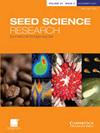开花植物不同生命形式的种子质量和基因组大小的相关进化不同
IF 1.9
3区 生物学
Q2 PLANT SCIENCES
引用次数: 6
摘要
摘要种子作为植物再生单位在物种之间表现出重要的变异,但它们与其他植物特征的进化协同变异仍知之甚少。虽然已经记录了种子质量与基因组大小(GS)和生命形式的正相关,但从未对它们的进化相关性和适应性选择进行过大规模量化。在这里,我们测试了被子植物种子质量和GS向与生命形式相关的不同选择机制的相关进化。特别是,我们测试了这样一种假设,即一年生植物对较轻种子和较小基因组的选择更强,从而确保了较高的再生潜力。在包含3242个物种的数据集上使用多元进化模型,我们发现种子质量和GS的总体正相关进化偏离了纯漂移过程。相反,种子和基因组大小的进化变化是由不同生命形式对最优值的适应性选择驱动的。具体而言,种子和基因组大小进化的进化最优值显示出一年生植物中的小值、多年生草本植物中的中等值以及木本植物中种子质量和GS之间的权衡。此外,种子质量和GS之间的进化相关性在一年生植物中最强,这是为了适应在短时间窗口内完成其生命周期,此时环境条件有利于再生和发育成熟。由于生命形式,相关进化对种子和基因组大小的影响是不对称的,这可以解释生命史特征如何与功能特征相互作用,以及植物如何进化出不同的成功生命史策略。本文章由计算机程序翻译,如有差异,请以英文原文为准。
Correlated evolution of seed mass and genome size varies among life forms in flowering plants
Abstract Seeds show important variation as plant regenerative units among species, but their evolutionary co-variations with other plant characteristics are still poorly understood. Whilst a positive association of seed mass with genome size (GS) and life forms has already been documented, a broad-scale quantification of their evolutionary correlation and adaptive selection has never been conducted. Here, we tested for correlated evolution of seed mass and GS towards distinct selective regimes related to life form in angiosperms. In particular, we tested the hypothesis that the selection toward lighter seeds and smaller genomes is stronger for annual plants, ensuring high regenerative potential. Using multivariate evolutionary models over a dataset containing 3242 species, we showed an overall positive correlated evolution of seed mass and GS deviating from a pure drift process. Instead, evolutionary changes in seed and genome sizes were driven by adaptive selection towards optimal values differing among life forms. Specifically, the evolutionary optima towards which the seed and genome sizes evolve show a covariation toward small values in annuals, intermediate values in perennial herbs and a trade-off between seed mass and GS in woody plants. Moreover, the evolutionary correlation between seed mass and GS is strongest in annuals as an adaption to complete their life cycle in a short time window, when environmental conditions are favourable for regeneration and development to maturity. The asymmetry in the correlated evolution acting on seed and genome sizes due to life form could explain how life-history traits interplay with functional traits and how plants have evolved diverse successful life-history strategies.
求助全文
通过发布文献求助,成功后即可免费获取论文全文。
去求助
来源期刊

Seed Science Research
生物-植物科学
CiteScore
3.60
自引率
4.80%
发文量
23
审稿时长
>12 weeks
期刊介绍:
Seed Science Research, the official journal of the International Society for Seed Science, is a leading international journal featuring high-quality original papers and review articles on the fundamental aspects of seed science, reviewed by internationally distinguished editors. The emphasis is on the physiology, biochemistry, molecular biology and ecology of seeds.
 求助内容:
求助内容: 应助结果提醒方式:
应助结果提醒方式:


